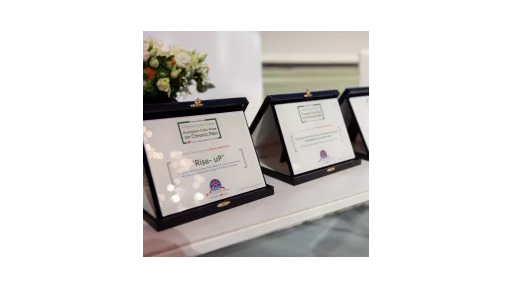4 best practices activities have been awarded today in Brussels, thanks to the second edition of the “EU Civic prize on Chronic Pain”, promoted by the Italian NGO Active Citizenship Network-Cittadinanzattiva during the annual symposium on the “Societal Impact of Pain” (SIP).
Active Citizenship Network (ACN) launched the project ”EU Civic Prize on Chronic Pain - Collecting good practices” to give evidence of the existing good practices in Europe in terms of struggle against pain, and based on the selection of the practices presented by different healthcare stakeholders. The prize provided an occasion for demonstrating what the community can offer in terms of good practices as well as sharing experiences useful for raising awareness about the condition, enhancing the body of knowledge of positive cases and success, and strengthening commitment on this topic. Throughout 2018 and 2019, this initiative has allowed us to collect 40 Good Practices coming from 12 different countries: Spain (13), Italy (10), Portugal (5) Belgium (3), France (2), Malta (1), Sweden (1), Germany (1), The Netherlands (1), Ireland (1), UK (1), and an extra EU country (1 from the Dominican Republic).
Divided into 4 categories (patients’ empowerment, innovation, professional education, clinical practices), the good practices were evaluated by a pool of international experts in chronic pain. Besides a representative of ACN, these experts came from the European Pain Federation (EFIC), the Sine Dolore European Pain Foundation, the European Hospital and Healthcare Federation (HOPE), the European Union of Private Hospitals (UEHP), the Pain Alliance Europe (PAE), the European Confederation of Care Home Organisations (ECHO), the European Multidisciplinary Network in Pain Research and Education (EMNIPRE), the European Headache and Migraine Alliance (EHMA) and from a retired university professor.
The main characteristic of the second edition of the “European Civic Prize on Chronic Pain” is that the 4 awarded best practices are all digital solutions for everyone, more precisely mobile apps. This underlines the growing role of digital health in the treatment of chronic pain. Indeed, today patients and Health Care Professionals have at their disposable a dizzying array of healthcare apps, which can be employed as part of the wellness, prevention or treatment regimes. Although this is certainly an interesting opportunity, we also need to consider what level of empowerment is required for patients to be able to take full advantage of these apps. For instance, as underlined by experts “there is some evidence that integrating digital health technology into older peoples’ pain self-management plan is feasible and acceptable. However, the provision of high-quality technological interventions informed by a thorough understanding of older people’s digital technology pain management needs is required to ensure greater integration of this technology in clinical practice”.
Active Citizenship Network is responsible for the scientific design and contents of this Project that has been realized with the financial and non-financial support of Grünenthal GmbH and Pfizer Inc.
“From the good practices collected it emerges clearly that, as often happens, it is the team and not the individual that wins: multidisciplinary medical teams, collaboration between the public and private sectors, dialogue between the world of research and patient associations, involvement of civil society, etc. they are always present in most of these experiences. Moreover, the fact that this year apps won all the prices, say a lot about the growing importance of digital health”, declared Mariano Votta, Director of ACN-Cittadinanzattiva, “
The 4 Winners
The Jury of Active Citizenship Network-Cittadinanzattiva, composed by health experts, has selected the 4 winners of the prize evaluating them for each of these four Criteria determined: reproducibility, innovation, added value, appropriateness. The winners will be given an expenses-paid visit to other winners’ headquarters and a publication in English on a suitable journal.
The four good practices awarded highlight the growing importance of smart and cost-effective solutions offered by eHealth & mHealth. At the same time, however, these innovations make us wonder if such opportunities are actually available to everyone or if – due to the digital divide existing among the different population’s groups within and especially between countries – they could involuntarily sharpen health disparities
- “MyDystonia” – winner for the category “patients’ empowerment”
MyDystonia, developed by Dystonia Europe (Belgium), is an electronic diary available as a web-based service and as a mobile APP for dystonia patients to record and analyze the impact of the disease on everyday life. By answering predefined questions (e.g. core symptoms like overactive muscles or pain; impact on daily living; etc.), the user is able to examine and to visualize their well-being according to the treatment schedule. The digital diary is designed to support and potentially improve patient-physician communication as the collected data can be presented and discussed with the treating physician or other patients in order to track the treatment’s outcome and to define potential treatment goals in order to attempt an optimized treatment approach. In the long-term, the objective is that all dystonia patients use the MyDystonia APP. The collected anonymized data can provide important information and knowledge on the daily life of dystonia patients and could lead to further research projects, improved treatments and hopefully a better quality of life for people living with dystonia.
- “DTX for PAIN” – winner for the category “innovation”
It is a digital therapeutics – developed by Lucine Group (France)- able to relieve patient’s pain through active substances allowing analgesic neurostimulation. Customized, this option is adapted to each patient thanks to the measurement and analysis of pain through facial, vocal, and postural recognition. “DTX for PAIN” is the first digital solution that can measure and analyze patient's pain level using facial, postural, vocal and environmental recognition. The smartphone’s camera analyzes the mobility of the face, the body, the emotional expressions, the semiotics of the language and the modulation of the patient's voice. After analyzing the data, “DTX for PAIN” delivers an objective measurement of the patient's pain level on a scale from 1 to 100 and analyses pain biomarkers. It is the first digital therapeutics to provide health solutions that act as an analgesic without the absorption of a conventional molecule. Thus, to relieve pain, it offers a library of "digital health therapeutics”. By relying on the cognitive and chemical abilities of the patient's brain, “DTX for PAIN” can lead to a chain of chemical antalgic responses thanks to auditory, visual and sensory stimulations. It uses two technological bricks: the first one is the machine’s learning and deep-learning process for the identification of subjective and objective pain biomarkers; the second one is the use of external stimuli leading to the physiological production of natural painkillers such as B-endorphin, serotonin, dopamine, etc. The use of behavioral therapies for a deep transformation of pain mechanisms is extremely important.
- “RED App” – winner for the category “professional education”
Developed by Niguarda Hospital (Italy), RED App is a mobile application with 4 main objectives: a) being a compass for citizens and general practitioners by providing information about pain care and the local Pain Care Network of Milan (“RED network”: centers, services, settings, contacts); b) facilitating communication between patients/primary care physician and pain care centers; c) sharing information and documents for physicians and patients on clinical pathway protocols and treatments; d) supporting the patient empowerment and the patient flow management within the network. The final goals are to enable the prompt access of patients referred by their general practitioners to the pain care specialists and - second - to improve the quality of pain care throughout the healthcare system by defining and sharing care protocols on the most common pain syndromes.
- “Rise-uP” – winner for the category “clinical practices”
“Rise-uP” is the main output of a project developed by by Center of Interdisciplinary Pain Medicine, Dep. of Neurology, MRI Munich, Technical University of Munich, Germany.
It aims to overcome the less structured treatment of acute and subacute unspecific low back pain in Germany. Although evidence has been provided which underlines the insufficient long-term efficacy of the present practice, i.e. not indicated surgery, medication or imaging, these measures still prevail with high costs for the health care system. In contrast, evidence-based interventions fostering patients’ empowerment are widely neglected. Furthermore, patients with increased risk of developing chronic pain are often not identified and treated insufficiently. Rise-uP aims to establish a guidelines-oriented treatment algorithm including telemedicine and mHealth coordinated by the general physician. The cores of the concept are twofold. Firstly, the main intervention is the Kaia App, a multidisciplinary back pain app providing the pillars of the multimodal pain therapy - physical exercise, psychological elements (mindfulness) and educational content about low back pain - on the patient’s mobile device. A daily training program is tailored to the particular patient via an algorithm and the patient is recommended to use the app “as often as possible”. Secondly, the risk of developing chronic pain is determined in the beginning of the treatment via a questionnaire (StartBack). Furthermore, questionnaires regarding pain intensity, functional ability, psychopathological symptoms and life quality are completed by the patient on a tablet on the first appointment with the GP. Then these data are transferred to a server. Patients with a high risk of developing chronic pain are monitored. Additionally, a pain specialist gets involved via telemedicine from the beginning of the treatment to maximally prevent the development of chronic pain. A shared electronic case report form which also guides the general practitioner through the treatment algorithm provides access to the patients’ data to all involved professionals.
Framework
The award ceremony is part of annual symposium of the “Societal Impact of Pain” (SIP), an international multi-stakeholder platform created as a joint initiative of the European Pain Federation EFIC® and Grünenthal with the aim to:
- raise awareness of the relevance of the impact that pain has on our societies, health and economic systems
- exchange information and sharing best-practices across all Member States of the European Union
- develop and foster European-wide policy strategies for an improved pain management in Europe (Pain Policy).
Over 300 international and national pain advocacy groups, scientific organisations and authorities have endorsed the scientific aims of SIP symposia and meetings.
The scientific framework of the “Societal Impact of Pain” (SIP) platform is under the responsibility of the European Pain Federation EFIC®. Cooperation partners for SIP 2019 are Pain Alliance Europe (PAE) and Active Citizenship Network (CAN). The pharmaceutical company Grünenthal GmbH is responsible for funding and non-financial support (e.g. logistical support). In the past the scientific aims of the SIP symposia have been endorsed by over 300 international and national pain advocacy groups, scientific organisations and authorities.




